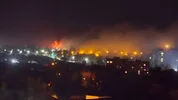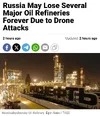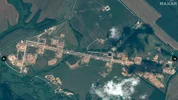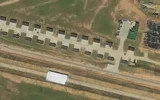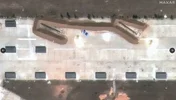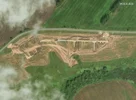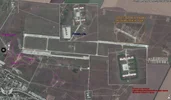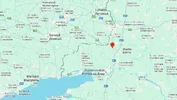How Russia is building airports to launch Iranian drones at Ukrainian cities
Europe
Since the beginning of 2025, Russia has been carrying out increasing raids using Shahed kamikaze drones. This Iranian-designed drone is raining down on Ukrainian cities in ever-increasing numbers, terrorizing the population. To fuel these attacks, Russia has built airports specifically designed for mass drone launches. The Observers editorial team consulted satellite images to locate these sites.
Published on:08/22/2025 - 4:20 PM
11 min
Reading time
By :
Guillaume MAURICE
/
The Observers
(katso kuva linkin takaa)
Russian Shahed kamikaze drones are raining down en masse on Ukrainian cities. To sustain a sustained bombing tempo, Russia has built bases to launch and store its drones. © Observers
The Shahed is a drone that knows no diplomacy. While Oval Office talks hint at a potential meeting between
Vladimir Putin and
Volodymyr Zelensky , Iranian-designed
Shahed-136 drones —also known as “Geran-2” by the Russians—continue to strike Ukrainian cities. According to the
Ukrainian Defense Ministry , 546 drones fell on cities in western
Ukraine during the night of August 20-21. For Ukrainian civilians, this drone, with a range of between 1,700 and 2,500 kilometers, represents the main threat. For the Russians, the Shahed is an unparalleled means of pressure, and the Russian military is quietly building airports specifically designed for the large-scale launch of these weapons.
(katso kuva linkin takaa)
The Shahed-136 drone used by Russia is small, 3.5 m long and 2.5 m wide, and easily transportable. © Cat-Uxo
Inexpensive, simple to manufacture, and easy to deploy, the Russians have been using Shahed drones against Ukraine since October 2022. The Shahed-136 reaches a maximum speed of 180 km/h and detonates itself upon hitting its target. While the drone's speed is significantly slower than that of a ballistic missile, the Shahed is easier to deploy. This drone is also easy to launch. It is possible to launch multiple drones from a truck or from a simple ground launch pad. A Shahed drone can even be launched from a simple pickup truck or SUV.
Above, a Chinese-made SUV converted by the Russian military into a Shahed drone launch platform. Below, a Russian-made Kamaz truck capable of launching two drones. © Observers
But the drone's greatest strength lies in the large number of units produced. Indeed, its cost is estimated at between $20,000 and $50,000, depending on the model's specifications. By comparison, the price of a
9M728 Iskander K cruise missile is estimated at between $1 million and $2 million. This low cost allows Russia to ensure a high rate of drone production.
(katso kuva linkin takaa)
This image, shared on Telegram in March 2024, shows a Russian factory for the large-scale production of Shahed drones. © Telegram
Since the beginning of 2023, the Shahed has been mass-produced on Russian soil under the name “Geran-2.” While the contribution of Chinese and, more rarely, Iranian components remains necessary, Russia is making its production autonomous. The Center for Strategic and International Studies (CSIS), an American think tank, estimates that the rate of Russian Shahed launches will increase from 200 per week in 2024 to more than 1,000 per week in 2025.
This map, published by the Ukrainian analyst group Monitoring War, shows the waves of Shahed drones (in yellow) and missiles (in red) that flew over Ukraine on the night of August 20-21, 2025. © Telegram/mon1tor_ua
“You can no longer sleep because you know there is a threat hanging over you.”
These drones are frequently involved in attacks on civilian infrastructure, sometimes causing
deaths among the population . These incessant raids affect the morale of the population, as described by a resident of central Ukraine who wished to remain anonymous:
"If a drone flies over my city, I can hear it, even from afar. The sound is like a very loud motorcycle with its exhaust removed. The air raid warning is activated, and you can't sleep because you know there's a threat to you and your loved ones. The Shahids are attacking Ukraine day and night. While we were talking to you, we received an air raid warning, and it has just been canceled. For the children, everything depends on the adults' reaction. We are doing everything we can to keep the children sleeping."
This graph, published in May 2025 by the Center for Strategic and International Studies, shows the evolution of the number of Shahed drones launched against Ukraine over the months. © CSIS Future Labs
Waves of hundreds of drones to “saturate” Ukrainian defenses
In addition to terrorizing the Ukrainian population, Shahed drones are used to overload Ukrainian missile defenses. An analyst with the
Ukraine Control Map group describes a two-pronged strategy
:
"The Russian doctrine for employing the Shahed is 'saturation'. It consists of overwhelming the air defenses in order to disperse them, which makes the Ukrainian batteries incapable of handling the volume of attacking drones. This tactic also allows Russia to map the Ukrainian air defense networks in order to target them.
While the Shahed are easy to detect by radar, their destruction at low cost is difficult due to the size of the area to be protected and the large number of targets requiring air defense.
Russia is therefore seeking to overwhelm Ukraine with its Shahed strikes. The scenes of Ukrainians hiding in subway stations are certainly reminiscent of Nazi Germany's Blitz against England during World War II.
According to a
study by the Center for Strategic and International Studies published in May 2025, Ukrainian air defenses are capable of shooting down 75% of Russian Shahed drones.
For
Daniele Barbera , of the Tochnyi investigative group , the Shahed also serve as bait for Ukrainian anti-aircraft defenses to allow the Russian missile to penetrate the defenses more easily:
"While air defenses know how to neutralize Shaheds, it is more difficult to destroy a large wave of Shaheds; especially when this wave of drones is coordinated with missile and aerial bomb attacks. [...] Often, Shahed drones are used to outflank Ukrainian defenses, allowing missiles to pass through and strike specific targets."
Infrastructure designed specifically for the Shahed
The Shahed's strength lies in numbers. To maintain constant pressure and fuel daily waves of drones, Russia is building new infrastructure. Thus, the borders of Russian territory are dotted with Shahed drone launch sites. The Ukrainian investigative group Oko Gora has identified 11 Russian Shahed drone launch
sites .
(katso kuva linkin takaa)
This image from July 17, 2025, shows Shahed drone launch pads positioned at Donetsk Airport in Russian-occupied Donbass. © MaxarTechnologies2025
Near the city of Oryol, 170 km northeast of Ukraine, is located the main Shahed drone launch hub: the Tsimbulova base. Nicknamed “the airport” by Ukrainians, the structure includes eight ground launchers and a 2.8-kilometer stretch of road for launching drones from vehicles. According to the Ukrainian investigative group
DniproOsint , the site can launch 14 drones simultaneously, and nearly 100 in a single night.
This satellite image released on August 14, 2025, shows Shahed drones parked in front of their storage bunker at Russia's Tsimbulova base. © MaxarTechnologies2025
Using a series of satellite images, it is possible to date the start of construction of the site to August 2024.
Satellite images show the progress of the construction of the drone launch site at Russia's Tsimbulova base between June 2024 and May 2025. Location: 53.364701343443905, 35.82215622049165. © Copernicus Browser
This strategic site has already been the target of Ukrainian missile strikes. On January 26, 2025, the airport was hit by Storm Shadow missiles. Satellite images released by the Ukrainian analyst group
Cyber Boroshno show impacts on the bunkers.
The impact of Ukrainian missiles on a Russian drone launch site in Tsimbulova is visible in this image published on February 9, 2025, by the Cyber Boroshno analyst group. Location: 53.372340,35.800360. © Telegram/kiber_boroshno
As of August 2025, Russia continues to build new drone launch sites. The Observers editorial team has identified a potential site under construction near the village of
Asovitsa in the Bryansk region, 35 km from Ukraine.
This satellite image, taken by Maxar on August 10, 2025, shows a Shahed drone launch site located near the village of Asovitsa in Russia. Location: 52.32282673988489, 34.506064868010526. © MaxarTechnologies2025
Air bases adapted for drones
Russia is also rehabilitating airports to transform them into storage facilities for Shahed drones. This is the case at the Primorsko-Akhtarsk airbase. Located 230 kilometers from the front line, it can launch around ten drones simultaneously. Proof of its strategic importance to the Russian command is that it is protected by S-400 anti-missile batteries.
This map shows the composition of the Russian Primorsko-Akhtarsk airbase with its ground launchers (in yellow), warehouses (in red), and anti-aircraft missiles (in pink). Location: 46.05948751501472, 38.235667644909164. © Telegram/DniproOfficial
This satellite image taken on July 27, 2025, shows Shahed drones stored next to bunkers at Primorsko-Akhtarsk Airport in Russia. © MaxarTechnologies2025
Here too, the site has been targeted by Ukrainian missiles on several occasions. On the night of August 1 to 2, 2025, the airfield was targeted by a Ukrainian missile strike. The impacts of the submunitions, as well as traces of intense heat triggered by the fire, are visible in this satellite image.
These images show significant heat sources released by the August 2, 2025, Ukrainian missile strike against the Primorsko-Akhtarsk air base, a Russian facility modified to allow the launch of Shahed drones. © NASA FIRMS
Easy targets?
If journalists and online investigators can detect Russian drone launch facilities, it's clear that the Ukrainians know where they are, too.
Daniele Barbera of the Tochnyi investigative group explains why the Russians decided to group drones into these hubs:
"At first glance, the construction of these launch bases is quite strange. With satellite images, everyone knows where they are. They could be easy targets.
The Russians need this launch infrastructure because they are conducting waves of simultaneous drone launches. This requires significant logistics, and therefore appropriate infrastructure. Imagine, for each drone in the sky, you have to: transport the device to the launch zone, place the explosive charge, program the drone, and finally organize the launch. Multiply these tasks by dozens or hundreds of Shahed launches, and you have a logistical headache. It's therefore simpler to create suitable launch sites.
Before these bases were built, the Russians used mobile launchers that struggled to launch so many drones at once, and these older shelters were much less reinforced. They were therefore easier to destroy. The new bases are protected by missile batteries that can intercept other enemy missiles. Concentrating the drones in a single location makes them easier to protect.
The Shahed drone launch stations are located close to Ukrainian territory. This gives Ukrainian air defenses less time to react. If you launch the drones from a more distant area, the Ukrainians will have time to calculate the drones' trajectory and destroy them."
For the Ukrainian command, the destruction of these launch bases, as well as the Shahed drone production plants, is a priority. While negotiations with Russia could begin, drones continue to strike Ukrainian cities without interruption.


 Öljynsiirtoasema Unetšassa, Brjanskin alueella Venäjällä, palaa jälleen kirkkaasti. Ylipäällikkö Robert "Madjar" Brovdi, joka johtaa miehittämättömien järjestelmien joukkoja, on julkaissut videon tulipalosta, joka tapahtui eräässä strategisesti tärkeässä Družba-pääöljyputken solmukohdassa.
Öljynsiirtoasema Unetšassa, Brjanskin alueella Venäjällä, palaa jälleen kirkkaasti. Ylipäällikkö Robert "Madjar" Brovdi, joka johtaa miehittämättömien järjestelmien joukkoja, on julkaissut videon tulipalosta, joka tapahtui eräässä strategisesti tärkeässä Družba-pääöljyputken solmukohdassa. Venäläiset lähteet raportoivat, että Ukrainan asevoimien droonit ovat tuhonneet Unetšan pumppaamolla viimeiset kolme öljynsiirtoon käytettävää yksikköä. Družba-öljyputken toiminta on täysin pysähtynyt.
Venäläiset lähteet raportoivat, että Ukrainan asevoimien droonit ovat tuhonneet Unetšan pumppaamolla viimeiset kolme öljynsiirtoon käytettävää yksikköä. Družba-öljyputken toiminta on täysin pysähtynyt.



